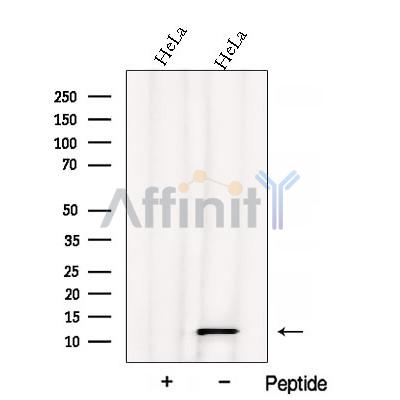ATPIF1 Antibody - #DF12846
| Product: | ATPIF1 Antibody |
| Catalog: | DF12846 |
| Description: | Rabbit polyclonal antibody to ATPIF1 |
| Application: | WB |
| Reactivity: | Human, Mouse, Monkey |
| Prediction: | Pig, Bovine |
| Mol.Wt.: | 12 kDa; 12kD(Calculated). |
| Uniprot: | Q9UII2 |
| RRID: | AB_2845807 |
Related Downloads
Protocols
Product Info
*The optimal dilutions should be determined by the end user. For optimal experimental results, antibody reuse is not recommended.
*Tips:
WB: For western blot detection of denatured protein samples. IHC: For immunohistochemical detection of paraffin sections (IHC-p) or frozen sections (IHC-f) of tissue samples. IF/ICC: For immunofluorescence detection of cell samples. ELISA(peptide): For ELISA detection of antigenic peptide.
Cite Format: Affinity Biosciences Cat# DF12846, RRID:AB_2845807.
Fold/Unfold
ATIF1_HUMAN; ATP synthase inhibitor protein; ATPase inhibitor; ATPase inhibitor mitochondrial; ATPase inhibitor protein; ATPase inhibitory factor 1; ATPI; ATPIF 1; Atpif1; ATPIP; IF(1); IF1; Inhibitor of F(1)F(o)-ATPase; IP; MGC1167; MGC8898; mitochondrial;
Immunogens
A synthesized peptide derived from human ATPIF1, corresponding to a region within the internal amino acids.
- Q9UII2 ATIF1_HUMAN:
- Protein BLAST With
- NCBI/
- ExPASy/
- Uniprot
MAVTALAARTWLGVWGVRTMQARGFGSDQSENVDRGAGSIREAGGAFGKREQAEEERYFRAQSREQLAALKKHHEEEIVHHKKEIERLQKEIERHKQKIKMLKHDD
Predictions
Score>80(red) has high confidence and is suggested to be used for WB detection. *The prediction model is mainly based on the alignment of immunogen sequences, the results are for reference only, not as the basis of quality assurance.
High(score>80) Medium(80>score>50) Low(score<50) No confidence
Research Backgrounds
Endogenous F(1)F(o)-ATPase inhibitor limiting ATP depletion when the mitochondrial membrane potential falls below a threshold and the F(1)F(o)-ATP synthase starts hydrolyzing ATP to pump protons out of the mitochondrial matrix. Required to avoid the consumption of cellular ATP when the F(1)F(o)-ATP synthase enzyme acts as an ATP hydrolase. Indirectly acts as a regulator of heme synthesis in erythroid tissues: regulates heme synthesis by modulating the mitochondrial pH and redox potential, allowing FECH to efficiently catalyze the incorporation of iron into protoporphyrin IX to produce heme.
Exhibits variability in chain length, mitochondria have distinct pools of protein cleaved after the 24th, 25th, and 26th amino acid.
Mitochondrion.
Forms an alpha-helical dimer with monomers associated via an antiparallel alpha-helical coiled coil composed of residues 74-106, leaving each N-terminal inhibitory region (residues 26-52) accessible for interaction with an F1 catalytic domain. The inhibitory N-terminal region (residues 26-52) binds the alpha(ADP-bound)-beta(ADP-bound) (ATP5F1A-ATP5F1B) interface of F1-ATPase, and also contact the central gamma subunit (ATP5F1C). This dimeric state is favored by pH values below 7.0, and at higher values the dimers associate to form inactive homotetramer, where the inhibitory region is occluded, masking its inhibitory activity (By similarity).
Belongs to the ATPase inhibitor family.
Restrictive clause
Affinity Biosciences tests all products strictly. Citations are provided as a resource for additional applications that have not been validated by Affinity Biosciences. Please choose the appropriate format for each application and consult Materials and Methods sections for additional details about the use of any product in these publications.
For Research Use Only.
Not for use in diagnostic or therapeutic procedures. Not for resale. Not for distribution without written consent. Affinity Biosciences will not be held responsible for patent infringement or other violations that may occur with the use of our products. Affinity Biosciences, Affinity Biosciences Logo and all other trademarks are the property of Affinity Biosciences LTD.

